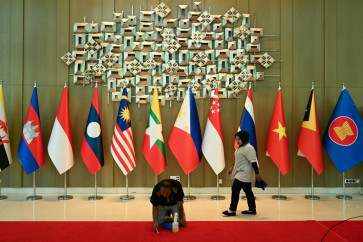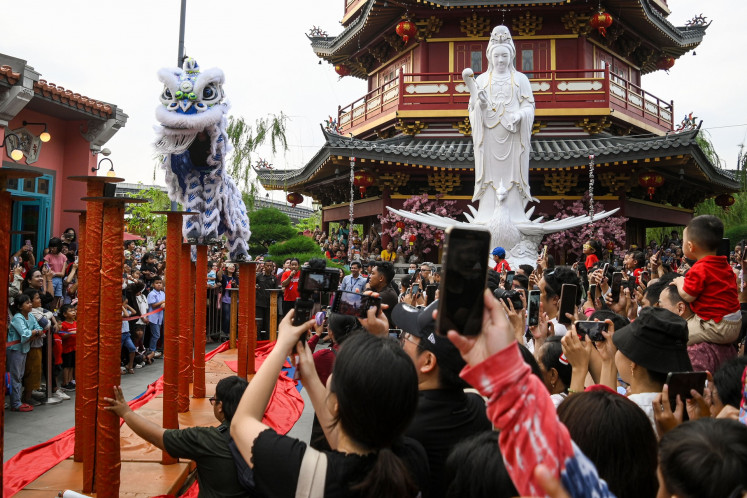Growing demand for safe and sound gated communities
Many young couples prioritize security and comfort when it comes to choosing their residential area, leading to the increasing popularity of gated communities known locally as “cluster housing” estates
Change text size
Gift Premium Articles
to Anyone

M
any young couples prioritize security and comfort when it comes to choosing their residential area, leading to the increasing popularity of gated communities known locally as “cluster housing” estates.
“Security is definitely number one, and the next is comfort that includes easy access to transportation,” said Suntoro, 40, whose family is one of 300 living in the Delatinos compound in Bumi Serpong Damai (BSD).
“I never feel worried about my house, even when I have to go out of town for a couple of days for a job assignment or for diving. If I go out of town with my family, I just deposit my house key at a security post and I have peace of mind.”
The housing estate adopts the concept of a cluster of residences to guarantee the security and comfort of its occupants. Like gated communities abroad, it applies a one-door security system that gives an exclusive added value and a higher level of privacy. Children can freely and safely play outside as security is well maintained.
“Anyone who wants to get into the housing compound must first report to the security guard. In this way, privacy is maintained and possible incidents [of theft] can be avoided. Once or twice I forgot to lock the door and brought a bicycle inside the house, but it was safe and nothing happened.”
Gated communities are also known for their provision of extensive amenities.
“Another thing that I like is that several kinds of workout facilities are available, such as a fitness center, a tennis court, badminton, futsal, a basketball court and a swimming pool. I can jog early in the morning because a jogging track is here,” Suntoro said.
Syrli Novianti, a young mother, enjoys residing in a cluster area because of the convenience in caring for her child.
“A kindergarten is only a stone’s throw away from my house and so I can accompany my daughter to school on foot,” she said.
“My daughter can freely and safely play outside the house because the security is well maintained. Cars or motorcycles that pass the compound’s road run slowly and we do not have to worry about being hit by a car or motorcycle.”
With most of the occupants being young couples, she said, her daughter has friends her age.
“When my daughter is out of the house, there’s no need to worry about her because I know where and with whom she plays,” she said.
As for daily cooking, she said, she can place an order on what she wants, such as fresh fish and vegetables by calling a vegetable seller nearby and in a few minutes, the seller will come with what she wants. “But I frequently just go on foot to reach a spot where I can get materials for daily cooking early in the morning, which is also good for exercise,” said Syrli, who lives in the Sevilla compound, also in BSD.
Yusuf Sugiarto, a father of three small children, said that even though it is located in the center of the city, the Taman Shangri-la housing estate where he lives is quiet because it is far from the center of the bustle.
Many young urban families, including Suntoro, Syrli Novianti and Yusuf Sugiarto, have discovered the benefits of living in a housing estate that adopts the concept of cluster residences.
It is no surprise, therefore, to learn that major property developers PT Agung Podomoro Land (APLN), PT Alam Sutera Realty Tbk, Summarecon, PT Bumi Serpong Damai Tbk, PT Jakarta Setiabudi International (JSI) and Sinarmas are focusing on developing housing estates that adopts the concept to take advantage of the growing demand for cluster houses.
The increasingly tight competition in housing has prompted developers to create their own ingredients to lure prospective consumers. For instance, APLN, which is developing the Green Permata Residence, will present “Island of Bali” nuances with cleanliness.
“We refer to Singapore when it comes to keeping clean,” said APLN vice president of corporate marketing Indra Widjaja Antono.
Johannes Mardjuki, director of Summarecon, said that the company always strived to keep its promises expressed during the pre-emptive market phase.
“For instance, if we promise to use high-quality ceramics for the floor, we have to make sure that our contractor really uses first-class ceramics instead of second or third class materials. Or if consumers wish to use a light-steel frame for the ceiling, we don’t replace it with a wooden frame,” he said.
To ensure that the quality of building materials suits the original plan, the developer applies a “reward and punishment” system to appointed contractors.
On top of that, he said, “we stick to our building concept that emphasizes safety, comfort and a natural setting.”
PT Alam Sutera Realty Tbk emphasized such consistency with its adoption of the Ecological Planning method created by Ian McHarg, a landscape architect from Scotland, to anticipate a growing trend in green living. The developer uses the green concept to appeal to customers.
“For instance, a zoning plan is made to manage water channeled to housing or commercial estates. Everything is analyzed to create a map, which is then developed into a master plan that is able to create sustainable living for both the environment and the corporation,” the developer said.
Knowing that a house in the Javanese culture serves as a place for big family gatherings prompted PT Jakarta Setiabudi International (JSI), through subsidiary PT Antilope Madju, to develop the Hyarta Residence in Yogyakarta.
The architectural design of the planned construction of 75 units will accommodate occupants’ need to get together and to increase family bonds, according to Hyarta Residence’ project manager Yohan Salim.
“The houses to be built in clusters will also accommodate the Javanese lifestyle reflected in Joglo-stylized roof and functions of rooms that accommodate modern lifestyles,” he said.









